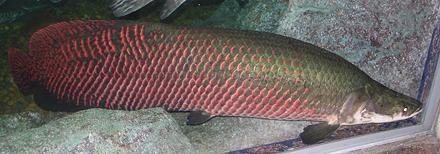 [Pirarucu (Brazil, from Tupi); Paiche (Bolivia);
Arapaima gigas, Arapaima arapaima (most common variety of
A. gigas, possible species). a few other species exist]
[Pirarucu (Brazil, from Tupi); Paiche (Bolivia);
Arapaima gigas, Arapaima arapaima (most common variety of
A. gigas, possible species). a few other species exist]
This fish, one of the largest freshwater fish in existence, is native to rivers and lakes of the Amazon Basin and the Essequibo River basin north of Brazil. It can grow to over 10 feet long and 440 pounds, but is most common at about a little over 6 feet. and around 180 pounds. It must breath air, which gives it a great advantage as a predator in low oxygen environments, but also makes it vulnerable to spearing. IUCN Red List DD (Data Deficient). Photo by Bjoertvedt distributed under license Creative Commons Attribution-ShareAlike v3.0 unported".
This fish has been severely overfished, so fishing it is now strictly controlled in Brazil, and populations are recovering. It is now farmed in South America and Southeast Asia, and has escaped into rivers and lakes in some locations, including Bolivia and Karala, India. In lakes in Thailand it is a popular "catch and release" fish.
More on Varieties of fish (very
large page).
Arapaima flesh has a faintly reddish color. Due to the size of the fish it is sold as chunks of fillets. In its native region it is often smoked or more commonly salt cured, then rolled up and tied in cylinders.
Buying: Not common outside its native region, but Whole Foods has sold frozen chunks of fillet from farmed fish in the USA. I have not seen it in the fish markets where I shop here in Southern California. It is sold mainly as chunks of fillets, frozen if outside local markets.
Cooking: This fish is sometimes called "Amazon Cod" and can be cooked by any method used for Cod. Dried and salted it can be handled the same way as Bacalao (Salted Cod).
Yield: A single fish can yield 150 pounds of flesh. As sold in chunks of fillets, yield is about 100%.
Scales: This fish is covered with very large hard strong piranha resistant scales, often used as fingernail files. Fortunately, you won't have to deal with them unless you get a fresh fish in Brazil.
Skin: The skin is tough, and is now being use for expensive leather goods.
Stock: I have no details on this
sf_arapaz 240506 - www.clovegarden.com